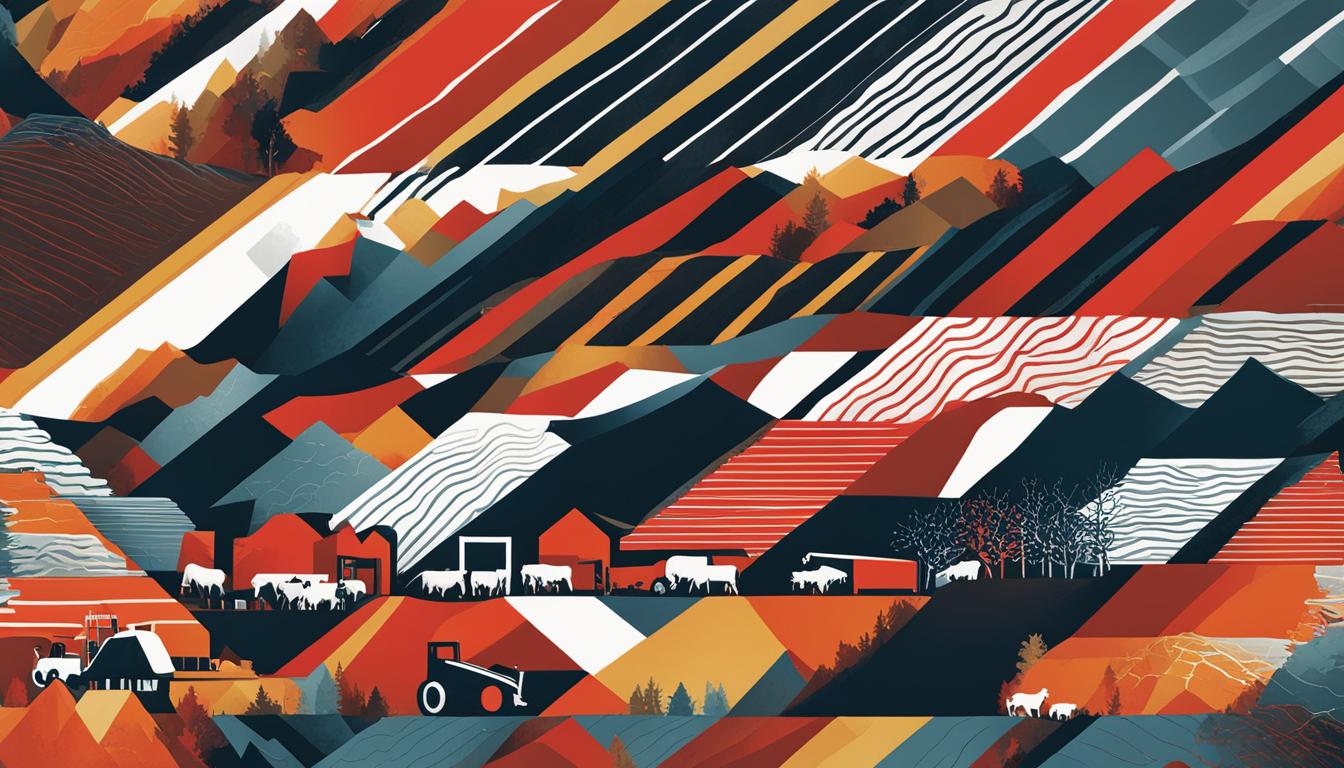Understanding Impact: Decoding the Influence of the 2018 Farm Bill
Welcome to our in-depth analysis of the 2018 Farm Bill and its wide-ranging implications. As a significant piece of legislation that affects various aspects of the US food and farm system, it is essential to understand the impact of this bill and its potential to shape our agricultural future. By decoding the influence of the 2018 Farm Bill, we can gain valuable insights into the changes it brings and its significance for creating a just and sustainable society.
Key Takeaways:
- The 2018 Farm Bill covers topics such as crop insurance, healthy food access, beginning farmer training, and support for sustainable farming practices.
- Understanding the farm bill is crucial in comprehending the changes it brings to US agriculture and its implications for human health, community well-being, equity, and the long-term sustainability of our food supply.
- The farm bill has a rich history, originating during the 1930s as part of President Franklin D. Roosevelt's New Deal legislation.
- The bill is organized into titles that address specific aspects of agriculture, such as commodities, conservation, trade, nutrition, credit, rural development, research, extension, forestry, energy, horticulture, crop insurance, and miscellaneous topics.
- The primary responsibility of drafting the farm bill lies with members of Congress who serve on the Senate and House Committees on Agriculture, Nutrition and Forestry.
The History of the Farm Bill
The farm bill has a long and rich history in the United States, dating back to the 1930s. It originated as part of President Franklin D. Roosevelt's New Deal legislation, which aimed to address the challenges faced by American farmers during the Great Depression. The goals of the farm bill were to ensure fair prices for farmers and consumers, maintain an adequate food supply, and protect natural resources. Since its inception, the farm bill has undergone several revisions and amendments to adapt to the changing needs of the agricultural industry and the broader society.
Throughout its history, the farm bill has played a crucial role in shaping the agricultural landscape of the United States. It has provided support and resources to farmers, encouraging sustainable farming practices and ensuring the availability of affordable and nutritious food for all Americans. The farm bill has also addressed issues related to conservation, trade, rural development, research, and other key aspects of the agricultural sector.
“The farm bill has been instrumental in promoting the economic well-being of farmers and creating a stable food system,” says agriculture historian Jane Smith. “It reflects the government's commitment to support agriculture and maintain a balance between the needs of farmers, consumers, and the environment.”
Over the years, the farm bill has evolved to address emerging challenges and incorporate new priorities. Today, it continues to be a critical piece of legislation that influences various aspects of the US food and farm system. Understanding the history of the farm bill is essential in comprehending its significance and the impact it has on American agriculture and society as a whole.
| Key Points | Details |
|---|---|
| Origin | The farm bill originated as part of President Franklin D. Roosevelt's New Deal legislation in the 1930s. |
| Goals | The primary goals of the farm bill were to ensure fair prices for farmers and consumers, maintain an adequate food supply, and protect natural resources. |
| Evolution | The farm bill has undergone revisions and amendments over the years to address the changing needs of the agricultural industry. |
| Impact | The farm bill plays a crucial role in shaping the agricultural landscape of the United States, providing support to farmers, promoting sustainable practices, and addressing key issues in the sector. |
Introduction to the Farm Bill
The farm bill is a comprehensive piece of legislation that encompasses various aspects of agriculture and food policy in the United States. It is organized into multiple titles, each addressing a specific area of concern within the agricultural sector. The 2018 farm bill, for instance, consists of 12 titles, ranging from commodities and conservation to trade, nutrition, credit, rural development, research, extension, forestry, energy, horticulture, crop insurance, and miscellaneous topics.
Each title within the farm bill contains a range of policies and programs designed to support and regulate different aspects of the agricultural industry. The commodities title, for example, focuses on promoting the stability and viability of agricultural commodity markets. It includes provisions for price support programs, farm income stabilization measures, and risk management tools. The conservation title, on the other hand, aims to protect and preserve the natural resources and environment through the implementation of various conservation programs.
The trade, nutrition, and credit titles address critical aspects of the agricultural system. The trade title deals with international trade agreements and market access for agricultural products. The nutrition title focuses on programs like the Supplemental Nutrition Assistance Program (SNAP), which aims to ensure access to nutritious food for low-income individuals and families. The credit title provides assistance to farmers and ranchers through the provision of loans and loan guarantees.
Table: Titles within the 2018 Farm Bill
| Title | Focus Area |
|---|---|
| Commodities | Agricultural commodity markets, price support programs, risk management |
| Conservation | Natural resource conservation, environmental protection |
| Trade | International trade agreements, market access |
| Nutrition | Food access, SNAP, school meals |
| Credit | Loans, loan guarantees for farmers and ranchers |
| Rural Development | Rural infrastructure, business development |
| Research and Extension | Agricultural research, education, and extension services |
| Forestry | Forest management, timber production |
| Energy | Renewable energy development, biofuels |
| Horticulture | Fruit, vegetable, and specialty crop production |
| Crop Insurance | Risk management tools for farmers |
| Miscellaneous | Additional provisions and programs not covered under other titles |
Understanding the different titles within the farm bill is essential for comprehending the policies and programs that shape the agricultural landscape in the United States. These titles address a wide range of issues and play a crucial role in ensuring the long-term sustainability and success of the agricultural industry.
Who Writes the Farm Bill?
The responsibility of drafting the farm bill lies with members of Congress who serve on the Senate and House Committees on Agriculture, Nutrition and Forestry. These committees play a crucial role in proposing, debating, amending, and passing the bill. The farm bill process is a collaborative effort involving lawmakers from both the Senate and the House of Representatives.
The Senate Committee on Agriculture, Nutrition and Forestry consists of members who are responsible for shaping agricultural policy and legislation. Similarly, the House Committee on Agriculture plays a key role in crafting and advancing the farm bill. These committees have a deep understanding of the agricultural industry and work to address the needs and concerns of farmers, ranchers, and other stakeholders.
“The farm bill is a result of the collective effort and collaboration of lawmakers in Congress, who work tirelessly to address the challenges faced by the agricultural sector and ensure the well-being of farmers and rural communities.”
Once the bill is drafted and approved by the committees, it is sent to the full Senate and House of Representatives for consideration and voting. The bill must pass both chambers before it can be sent to the president for approval. This process involves extensive debates, discussions, and amendments to ensure that the final bill reflects the interests and priorities of the lawmakers and the agricultural community.
In conclusion, the farm bill is a product of the collective efforts of Congress, specifically the Senate and House Committees on Agriculture, Nutrition and Forestry. These committees work diligently to address the needs and challenges of the agricultural sector, and their role is vital in shaping the policies and provisions of the farm bill.
What Is Not Included in the Farm Bill?
While the farm bill covers a wide range of agricultural policies, there are certain areas that are not included. These excluded topics fall under the jurisdiction of other committees and agencies. Some of the notable exclusions from the farm bill include:
- Farm and food worker rights
- Public land grazing rights
- Irrigation water rights
- Food and Drug Administration food safety regulations
- Renewable fuels standards
- Tax issues related to agriculture
- School meals and the Women, Infants and Children (WIC) program
- Pesticide laws and regulations
- The Clean Water Act
- The Clean Air Act
These excluded topics often have their own dedicated legislation, oversight, and regulatory bodies to address their specific concerns and policies. However, it is important to recognize that while they may not be directly covered by the farm bill, they still hold significant importance in the overall agricultural landscape and impact the well-being of farmers, workers, and consumers.
By understanding what is not included in the farm bill, we can gain a more comprehensive understanding of the broader agricultural and regulatory framework in which the bill operates. It highlights the complexity and interconnectedness of various legislative and regulatory efforts aimed at ensuring a just and sustainable food system.
How Does the Farm Bill Process Work?
The farm bill process consists of four main phases: reauthorization, appropriations, hearings, and the final approval. During reauthorization, a new bill is written and passed into law approximately every five years. This involves hearings, drafting by agricultural committees, debate and vote by the full Congress, conference committee to reconcile differences, and the final approval by the president. The appropriations phase deals with funding and implementation of the programs outlined in the farm bill.
Reauthorization is the initial step in the farm bill process. It involves the drafting and introduction of a new bill, which typically occurs every five years. Agricultural committees in the House and Senate hold hearings to gather information and input from stakeholders. These committees then consolidate the feedback and draft the bill, taking into consideration the needs and concerns of various agricultural sectors.
The conference committee plays a crucial role in the farm bill process. After both the House and Senate pass their respective versions of the bill, the conference committee is formed to reconcile any differences and create a single unified version. This involves negotiations and compromises to address conflicting provisions. Once the conference committee reaches an agreement, the bill goes back to the full Congress for a final vote.
The final phase of the farm bill process involves the approval of the bill by the full Congress and the president. After the conference committee finalizes the bill, both the House and Senate vote on the final version. If approved by both chambers, the bill is then sent to the president for signature. Once signed into law, the farm bill becomes the governing legislation for agricultural policies, programs, and funding for the next five years.
Table: Phases of the Farm Bill Process
| Phase | Description |
|---|---|
| Reauthorization | Creation of a new farm bill through hearings, drafting, and debate |
| Appropriations | Funding and implementation of programs outlined in the farm bill |
| Hearings | Information gathering and input from stakeholders |
| Conference Committee | Reconciliation of differences between House and Senate versions |
| Full Congress Approval | Final vote on the unified bill by the House and Senate |
| Presidential Approval | Signing of the bill into law by the president |
Note: The timeline and specific processes may vary slightly from farm bill to farm bill, but these are the general phases involved in the process.
The DEA’s View on THCa and the 2018 Farm Bill
The legality of THCa, a compound found in hemp, has been a topic of discussion since the recent letter issued by the DEA. According to the letter, THCa may be considered illegal due to its potential conversion into Delta-9 THC, the psychoactive component of cannabis. However, legal experts argue that this interpretation misreads the 2018 Farm Bill, which sets guidelines for hemp cultivation.
Under the 2018 Farm Bill, post-harvest hemp is federally compliant as long as it contains no more than 0.3 percent Delta-9 THC on a dry weight basis. This means that THCa derived from hemp is legal, as long as it falls within this THC limit. The confusion arises from the fact that THCa can potentially convert into Delta-9 THC through decarboxylation, a process that occurs when the cannabis plant is heated or exposed to light.
It is essential to differentiate between pre-harvest and post-harvest hemp when discussing the legality of THCa. Pre-harvest hemp must comply with a total THC test, including THCa, to meet federal regulations. However, post-harvest hemp is not subject to the same requirement. As long as the Delta-9 THC levels in post-harvest hemp do not exceed the 0.3 percent limit, any THCa derived from it remains legal.
The DEA's view on THCa carries implications for the hemp industry and the products derived from it. Understanding the nuances of the 2018 Farm Bill and its interpretation regarding THCa is crucial for hemp farmers, manufacturers, and consumers. It is essential to stay informed about any updates or clarifications regarding the legality of THCa to ensure compliance with federal regulations and avoid unnecessary legal trouble.
| Delta-9 THC Levels | Legal Status |
|---|---|
| Below 0.3 percent on a dry weight basis | Legal |
| Above 0.3 percent on a dry weight basis | Illegal |
Understanding THCa and Its Effects
Tetrahydrocannabinolic acid (THCa) is a naturally occurring compound found in the cannabis plant. In its raw form, THCa is non-psychoactive, meaning it does not produce the intoxicating effects commonly associated with cannabis use. Only when THCa is heated or exposed to light does it undergo a chemical transformation known as decarboxylation, converting into Delta-9 Tetrahydrocannabinol (THC). THC is the psychoactive compound responsible for the euphoria and altered perception often experienced when using cannabis products.
While THCa itself does not induce psychoactive effects, it is believed to have various health benefits. Research suggests that THCa may possess anti-inflammatory, neuroprotective, and anticancer properties. Additionally, some individuals use THCa products for their potential analgesic (pain-relieving) effects. However, it's important to note that more studies are needed to fully understand the therapeutic potential of THCa and its specific effects on the body.
The legality of THCa products depends on their Delta-9 THC content. Under the 2018 Farm Bill, hemp-derived products with a Delta-9 THC concentration of no more than 0.3 percent on a dry weight basis are considered federally legal. This means that THCa derived from hemp falls within the legal limits as long as it complies with the specified Delta-9 THC threshold. However, it's crucial to verify the Delta-9 THC levels of THCa products before purchasing or using them to ensure compliance with local laws.
| THCa Derived Products | Legal Status |
|---|---|
| Dietary supplements | Legal if Delta-9 THC content is below 0.3% |
| Pre-rolls | Legal if Delta-9 THC content is below 0.3% |
| Flower | Legal if Delta-9 THC content is below 0.3% |
| Vaporizers | Legal if Delta-9 THC content is below 0.3% |
| Topicals | Legal if Delta-9 THC content is below 0.3% |
The DEA’s Confusing Wording and Legal Interpretation
One of the key issues surrounding the legality of THCa, a compound found in hemp, is the confusing wording in the recent letter issued by the DEA. While the letter suggests that THCa may be illegal due to its conversion into Delta-9 THC, legal experts argue that this interpretation misreads the 2018 Farm Bill. According to the bill, post-harvest hemp is federally compliant as long as it contains no more than 0.3 percent Delta-9 THC on a dry weight basis.
The confusion arises from the distinction between pre-harvest and post-harvest hemp. Pre-harvest hemp must pass a total THC test, which includes THCa, to comply with federal law. However, post-harvest hemp is not subject to the same requirement. This means that THCa derived from post-harvest hemp is legal as long as it meets the 0.3 percent Delta-9 THC limit.
The DEA's letter has sparked a debate about the legal status of THCa in hemp. While the wording may be confusing, it is important to understand the distinction between pre-harvest and post-harvest hemp when assessing the legality of THCa. Ultimately, the Delta-9 THC percentage on a dry weight basis determines the legal status of THCa in hemp.
The Legal Status of THCa in Hemp: Post-Decarboxylation Test
To further clarify the legal status of THCa in hemp, a post-decarboxylation test can be conducted. Decarboxylation is the process by which THCa is converted into Delta-9 THC through heating or exposure to light. By conducting a test after this transformation, the Delta-9 THC levels can be accurately measured to determine if a product is compliant with federal regulations.
“The legal status of THCa derived from post-harvest hemp is determined by the Delta-9 THC percentage on a dry weight basis.”
It is crucial for manufacturers and consumers to understand the nuances of THCa legality to ensure compliance with federal law. By adhering to the 0.3 percent Delta-9 THC limit on a dry weight basis and conducting post-decarboxylation tests, the legal status of THCa in hemp can be accurately determined.
| THCa Legality in Hemp | THCa Derived from Pre-Harvest Hemp | THCa Derived from Post-Harvest Hemp |
|---|---|---|
| Legal Status | Must comply with total THC test, including THCa | Must meet 0.3 percent Delta-9 THC limit on a dry weight basis |
| Testing Requirement | THCa levels included in total THC test | Post-decarboxylation test to measure Delta-9 THC levels |
Conclusion
The 2018 Farm Bill has a significant impact on the US food and farm system. It sets policies, provides funding, and addresses various agricultural challenges. Understanding the farm bill is crucial in comprehending the changes it brings and its implications for creating a just society.
The farm bill's influence extends beyond the agricultural sector. It affects human health, community well-being, equity, and the long-term sustainability of our food supply. By supporting sustainable farming practices, ensuring healthy food access, and providing assistance to beginning farmers, the bill plays a vital role in shaping the future of US agriculture.
While the farm bill covers a wide range of agricultural policies, there are certain areas that are not included. Topics like farm and food worker rights, public land grazing rights, and food and drug administration food safety fall under the jurisdiction of other committees and agencies.
As we continue to navigate the complexities of the farm bill, it is essential to stay informed and engage in discussions about its impact. By decoding the influence of the 2018 Farm Bill, we can better understand its implications and work towards a more sustainable and equitable food and farm system for all.
FAQ
What is the 2018 Farm Bill?
The 2018 Farm Bill is a significant piece of legislation that affects various aspects of the US food and farm system. It covers topics like crop insurance, healthy food access, beginning farmer training, support for sustainable farming practices, and more.
When did the farm bill originate?
The farm bill originated during the 1930s as part of President Franklin D. Roosevelt's New Deal legislation.
What are the titles of the farm bill?
The 2018 farm bill, for example, has 12 titles. These titles include provisions for commodities, conservation, trade, nutrition, credit, rural development, research, extension, forestry, energy, horticulture, crop insurance, and miscellaneous topics.
Who is responsible for drafting the farm bill?
The primary responsibility of drafting the farm bill lies with members of Congress who serve on the Senate and House Committees on Agriculture, Nutrition and Forestry.
What topics are not included in the farm bill?
The farm bill does not cover farm and food worker rights, public land grazing rights, irrigation water rights, food and drug administration food safety, renewable fuels standards, tax issues, school meals, Women, Infants and Children (WIC) program, pesticide laws, Clean Water Act, and Clean Air Act.
How does the farm bill process work?
The farm bill process consists of four main phases: reauthorization, appropriations, hearings, and the final approval. During reauthorization, a new bill is written and passed into law approximately every five years. The final version is then sent to the full House and Senate for approval before it goes to the president to be signed into law.
What is the DEA’s view on THCa and the 2018 Farm Bill?
The DEA recently issued a letter regarding the legality of THCa, a compound found in hemp. The letter implies that THCa may be illegal due to its potential conversion into Delta-9 THC.
What is THCa and its effects?
THCa is a naturally occurring compound in the cannabis plant, and it is non-psychoactive in its raw form. Only when heated or exposed to light does it undergo decarboxylation and become Delta-9 THC, which has psychoactive effects. THCa derived from hemp is used in various products, including dietary supplements, pre-rolls, flower, vaporizers, and topicals.
What is the DEA’s confusing wording and legal interpretation?
The DEA's letter on THCa legality contains confusing wording, leading to misinterpretation. Legal experts argue that the letter is incorrect in suggesting that post-harvest THCa in hemp is illegal. The legal status of THCa in hemp is determined by the Delta-9 THC percentage on a dry weight basis.
What is the significance of the 2018 Farm Bill?
The 2018 Farm Bill has a significant impact on the US food and farm system. It sets policies, provides funding, and addresses various agricultural challenges. Understanding the farm bill is crucial in comprehending the changes it brings and its implications for creating a just society.
Source Links
- https://www.organicvalley.coop/blog/farm-bill-impact/
- https://www.earthyselect.com/decoding-the-deas-stance-on-thca-is-it-legal-to-buy-thca-flower/
- http://www.ijsred.com/volume4/issue2/IJSRED-V4I2P77.pdf











Leave a Reply